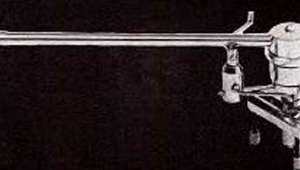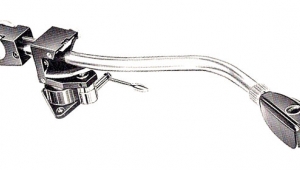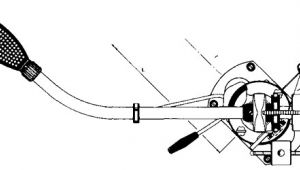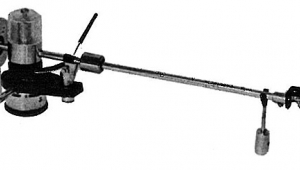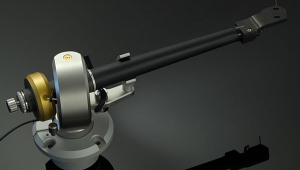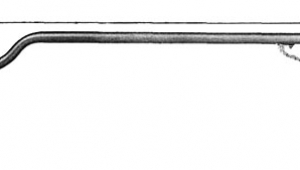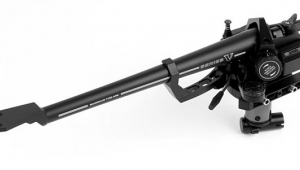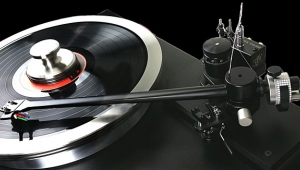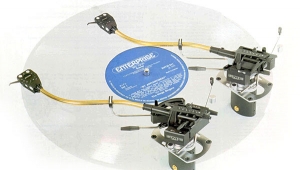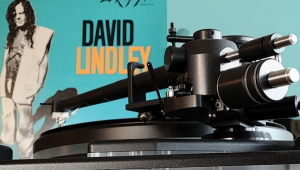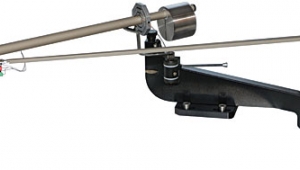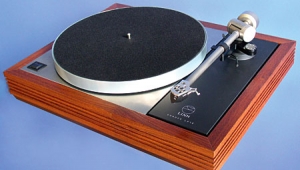| Columns Retired Columns & Blogs |
Graham Engineering Phantom B-44 tonearm Page 2
Unfortunately, neutral balance works both vertically and laterally, meaning that the arm would list one way or the other and then remain there, depending on its lateral weight distribution—not good. Graham's new Magneglide system solves the problem while providing an easy means of adjusting both azimuth angle and antiskating force.
The Magneglide system consists of an ABEC-7 grade horizontal bearing assembly—the same as SME uses for the main bearing of its V arm—of very low mass. The bearing's actual mass is 10gm, but since a large percentage of this mass, including the ball-bearing itself, at or near the center of rotation, its effective mass is much less. This assembly never "sees" the unipivot bearing—its only contact with the main bearing assembly is magnetic, via opposite-pole neodymium magnets: one on the assembly, one on the unipivot bearing housing, and both precisely located horizontally from the pivot point.
The magnets' magnetic forces act to laterally stabilize the arm at the pivot point and give it the feel of a traditional gimbaled arm. Even while playing a record, the arm will not roll. An adjustment screw lets you change the angle at which the two magnets meet, and thus sets azimuth by changing the angle of magnetic attraction; an assembly of rod, weight, and thread attached to the bearing assembly adjusts the antiskating force by physically deflecting the assembly from the position in which it would normally rest based on magnetic attraction alone. There is no physical contact between antiskating mechanism and bearing. Plus, the Magneglide bearing never makes contact or interferes with the unipivot bearing. As the arm traverses the record surface, both the main magnet and the one mounted on the Magneglide move, tracking it without contact and thus, hopefully, without lag.
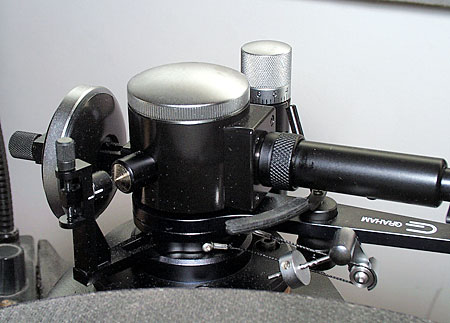
With the exception of the Magneglide azimuth adjustment, the Phantom sets up like the 2.2 in terms of VTA, VTF, antiskating, and geometry, which means setup is both convenient and repeatable—important features for a tonearm that lets you easily switch armtubes. If you want more details about Graham's ingenious remote gauge for adjusting overhang and zenith, see Dick Olsher's original review of the 1.5.
My biggest concern was the effect the Magneglide assembly might have on the Phantom's lateral tracking and responsiveness. Given the benefits of neutral balance and what seemed to be the pivot's true vertical stability, I figured that any tradeoff would probably be worth it.
The Sound of the Phantom
Because the Phantom is designed to be a drop-in replacement for the 1.5 and its successors, I was able to spend an hour listening to the combo of 2.2 and Lyra Titan cartridge and then, 15 minutes later, listen again, this time with the Titan in the Phantom's headshell. The biggest difference—which I heard easily, unmistakably, and immediately—was in the bottom octaves, where the Phantom delivered lightning strikes of deep, fast, ultratight bass. Massive attacks dissipated as quickly as they'd struck, leaving no residue.
I was moved to dig out Reference Recordings' famous Däfos (45rpm LP, RR-12), originally issued in 1983—I wasn't even in this business back then. A new generation of analog fans deserve to hear this collaboration by Brazilian percussionist Airto Moreira and Grateful Dead drummer Mickey Hart—especially The Beast, an enormous drum that Hart toys with, bangs, and, during "The Gates of Däfos," even sends crashing to the floor.
The Phantom's performance was dazzling on this audiophile warhorse and on all of the other discs I played, guiding the Lyra Titan to new performance heights—and not just at the very bottom. The Phantom is to the Graham 2.2 what Arnold Schwarzenegger is to Wally Cox (youngsters: do a Google search). That analogy may be over the top, but those who felt the original Graham was somewhat meek and reticent will have no such reservations about the Phantom.
The Phantom's bottom octaves had full weight, as well as the articulation and speed of the 2.2—but more than that, the Phantom delivered a harmonic vividness and sense of musical envelopment that even the 2.2 doesn't quite get. There was a greater expression of bloom and air, with no loss of detail or control. Every performance parameter seemed expressed with greater confidence and authority, including image solidity and stability.
The 2.2 was always an arm I could respect and—more important to a reviewer—rely on, but I never fell in love with it. That emotion seemed reserved for the Immedia RPM-2 tonearm, which is one reason I had both the 2.2 and the Immedia installed on a Yorke dual armboard. The Immedia has a lusher, richer balance than any of the earlier Grahams, as well as a more open, pristine, and liquid top end and a greater sense of musical flow. But the Phantom easily overtook the Immedia's superb overall performance, with greater stability, weight, transient articulation, speed, and, especially, a see-into-it transparency that is one of the Immedia's most attractive qualities. (Immedia's Allen Perkins told me at the 2005 Consumer Electronics Show that he's working on his own brand-new tonearm.)
The 2.2 could sound a bit on the mechanical and medicinal side of neutral and analytical; the Phantom is more like an exuberant figure skater who not only gets all the technical moves right, but also manages to exude an emotional intensity that borders on reckless abandon. The Phantom generates musical excitement even as it scores points on the compulsories.
Any worries I may have had about the Phantom's tracking abilities were quickly erased. The arm admirably acquitted itself on difficult musical passages and test tracks alike. It allowed the Lyra Titan to track the next-to-last, highly modulated antiskating track on the Hi-Fi News Analogue Test LP without any buzzing; more important, the combination's technical performance on musical torture tracks was flawless, particularly on difficult-to-track inner-groove orchestral crescendos and female vocal sibilants. So smooth and effortless was the Phantom's sibilant performance that I was reminded of Shure's 1973 Audio Obstacle Course: Era III LP (TTR-110), which includes Sergio Mendes and Brasil '66's "Mais Que Nada," recorded at increasingly higher levels. I hadn't played that cut in a long time, but I remembered never being able to track its sibilants properly at the higher levels. The Phantom and Titan sailed through it without smear.
Watching the Phantom confidently navigate a badly warped copy of Clannad's Crann Ull (Tara 3007) convinced me that Bob Graham's claims of the Phantom's neutral balance are justified. The Phantom tracked as if guided by lasers.
The Graham Phantom is a tonearm whose pure, effortless sound I can respect and love. Because it's a true unipivot but, unlike most such designs—which rely on a second pivot point or a constraining system with added contact points—it doesn't flop over, it feels good in the hand while retaining all of the benefits of a preloaded, single-point-bearing unipivot design. It's also easy to set up.
Because the heights of turntable platters, armboards, and playing surfaces are not standardized, some turntables and cartridges may require the addition of a spacer between the cartridge and the Phantom's headshell in order to get the optimal range of VTA adjustment. Graham provides a spacer made of Richlite, a composite of phenolic resin and wood fiber that incorporates some of the blue damping material also used in Graham headshells. Bob Graham says the spacer offers such outstanding damping properties that he recommends trying it even if you don't need it. The Lyra Titan didn't need it, and once I had it dialed in I wasn't about to start over, but I did try Graham's Nightingale cartridge with and without the spacer and can't say I heard any difference.
Conclusions
The Graham 2.2 remains an outstanding tonearm, so moving on to the Phantom wasn't the revelation that first hearing the 1.5 had been all those years ago. But the new Phantom is now the pivoted arm to beat, based on my listening experience and its physical and sonic performance and ease of use.
There are some other tonearm contenders that I have yet to hear, such as the Swiss DaVinci Audio Labs Grandezza and the Basis Vector. (Basis designer A.J. Conti won't send me a sample of the latter because he doesn't believe in cantilevered armboards—never mind that every arm I've reviewed has been on one, and no one has complained about the results I've heard.) I also wouldn't mind giving a listen to one of the Schöder arms, but Frank Schröder apparently can't keep up with demand—a review is the last thing he needs. Whatever those arms' sonic merits—they're said to be considerable—the Phantom's switchable armwands makes it an ideal choice for stereo/monophiles.
The Phantom, with all accessories, including Graham's unique alignment jig, will set you back $4275. Is it worth upgrading from the 2.2 or one of the older Graham arms? I was expecting a modest improvement when I dropped the Phantom into my system, but the differences were not subtle. (This will be especially true if, like me, you have a full-range system that goes down to 20Hz or below.) Only after the immediately obvious improvements had settled in did the subtler ones—those having to do with musical flow and a sense of certainty, those that kept me listening long into the night, night after night—begin to assert themselves.
- Log in or register to post comments
